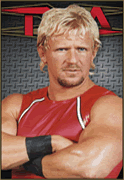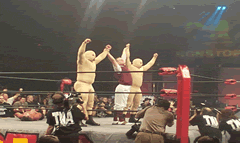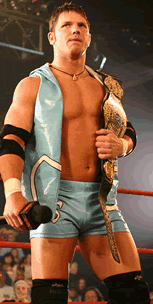As a special treat for all, to make up for all the columns I’ve missed, I’ve decided to lock myself away in a dark room and for the next few weeks, in several unique, and hopefully informative parts, share with you the history of NWA:TNA. It’s not totally in-depth, but it is a true account from many various sources of how the rise of TNA has come about. This week is part one, everything leading up to and including week one and two of Total-Nonstop Action.
We all know the story by now. In March 1998, three companies were revolutionising the wrestling business. Vince McMahons World Wrestling Federation was taking mainstream America into the era of “Attitude”, headlined by such stars as Stone Cold Steve Austin, Mick Foley, The Undertaker and D-Generation X. Eric Bischoff stood high above Georgia with the Ted Turner-owned World Championship Wrestling, trying to squeeze every last penny out of his highly-successful New World Order faction, but with promising new sensation Bill Goldberg taking the world by storm in a sea of “veterans” such as Sting, Ric Flair, Hulk Hogan, and The Outsiders. Down in Philadelphia, Paul Heyman and Extreme Championship Wrestling were fresh off their revolutionary boom, which actually wasn’t so revolutionary in the wrestling world, but definitely so in the United States, especially considering both Eric Bischoff and Vince McMahon were pinching wrestlers and ideas. His merry band of main stars included Taz, Bam Bam Bigelow, Sabu, and Rob Van Dam. Its easy to say all three were on top of the world.
Three years later, two of them were dead.
By February 2001, both WCW and ECW were on life support. WCW had a small glimpse of hope in Eric Bischoff’s consortium Fuscient Media Ventures. However, those plans never happened. Turner’s network wanted nothing to do with WCW, and Fuscient gave up. In March, Vince McMahon made his second offer (he has made an offer late in 2000, around November time, but nothing had become of it), and Turner accepted. For little less than $3 million, WCW was now property of the WWF. ECW, meanwhile, were trying their best to put on a brave face ahead of their Living Dangerously pay-per-view in March, but everyone knew it was over. The pay per view never happened. Rhino, Jerry Lynn, Yoshihiro Tajiri, Justin Credible and Spike Dudley all signed for the WWF. No sooner had Jerry Lawler walked out on his commentary duties due to a dispute over his partner Stacy Carter (they basically fired her – simple as that), Paul Heyman appeared on RAW alongside Jim Ross to call the show. The sad fact was there was nothing left for Heyman to do but join the WWF. His beloved ECW was done. Vince McMahon was the last man standing.
To briefly sum up the next year or so, the WWF brought in countless ex-WCW and ECW stars to begin an Invasion storyline. Suffice to say, it failed. It made money as far as the InVasion pay-per-view was concerned, but failed as far as being the storyline and money-spinner it could and should have been. It also failed to create any new stars apart from two – Booker T and Rob Van Dam. Both have since been lumbered in the mid card position and remain there to this day, despite several non-pushes. There are a number of reasons for the failure that I won’t address here, but the fact was, the WWF (which became the WWE in 2002 after losing a court battle with the World Wildlife Fund) was the only game in town, and now it was up to others to try and fill the void.
The first promotion to grab attention for trying to replace ECW was Main Event Championship Wrestling. It failed. However, it did set the tone for 3PW, created by Tod Gordon, The Blue Meanie and Jasmin St Claire. Xtreme Pro Wrestling tried to fill the ECW void also, but interest decreased and eventually, owners Rob Black and Lizzy Borden were arrested over trouble with their porn company Extreme Associates. Rob was also in trouble for a stunt in which he promised to eat a dog, and was somewhat hinted about (although never blatantly accused of) the attack on former XPW wrestler Messiah, who had been caught sleeping with Borden. Combat Zone Wrestling changed direction somewhat but still maintained a garbage element, and has seen better days as far as quality goes. The two biggest chances however, were Ring of Honor and Major League Wrestling. MLW was set up by Court Bauer and set up some killer events in 2003, pushing guys such as Steve Corino to the moon. However, bad financing made sure MLW never got past 2004. As for RoH, the company based on pleasing the Internet fans (well someone needs to) made major waves and continues to grow, although it will never be at ECW’s level (and to be fair, doesn’t necessarily want to be). It’s still running, and although I personally can’t stand the fed (technical wrestling without any entertainment has always and will continue to bore me), credit is due for their staying power.
But what about taking WCW’s place? Jimmy Hart and Andrew McManus both tried. Jimmy Hart, alongside Brian Knobs and Greg Valentine, set up X-Wrestling Federation, with moneybags Walter Smith behind them. They boasted a roster of Vampiro, Buff Bagwell, Curt Hennig, Jerry Lawler (the latter two were signed up by the WWE no doubt because of the XWF) and even Hulk Hogan. However, they couldn’t grow anymore without a TV deal which they couldn’t get unless they paid for it, and were already losing money. So the plug was pulled. Andrew McManus and the WWA achieved more success as a touring company. Taking wrestlers such as Sting, Jeff Jarrett and Scott Steiner to Great Britain and Australia was a great idea. However, the WWA failed miserably on US soil, and booking was often atrocious. WWA folded soon after.
There was one, however. One company that was set up in 2002, and is still here. One that was created (and I don’t care how often they deny it, they know it’s true) to provide fans with a new WCW. Introducing NWA:TNA.

The brains behind the idea were father and son Jerry and Jeff Jarrett. Jerry had plenty of experience in running a company, having co-owned the USWA with another Jerry – Jerry Lawler (who by this time was back in the WWE). Jeff was the former USWA, WWF and WCW worker who was left unemployed thanks to the McMahon buyout of WCW. He wasn’t signed up like Booker T and Diamond Dallas Page were. You see, Jeff wasn’t exactly in McMahon’s good books. Back in late 1999, Jeff’s good friend and WWF booker-at-the-time Vince Russo jumped over to WCW to accept writing job for more money and less work. Russo promised Jarrett a main event spot and a major push, and Jarrett accepted. Problem was, he was Intercontinental champion. So whilst in a feud with the face-turning Joanie ‘Chyna’ Laurer, Vince made the decision to have Jeff drop the belt. Jarrett decided he would, but in the process, held McMahon up to a six-figure sum to do so. Vince agreed, and Jarrett put Chyna over as required. Of course, different mouths tell different stories, and Jarrett to this day has no ill feelings towards the WWE. He has stated several times what the WWF meant to him. But obviously, bad blood was there, as Vince showed everyone on the night of the RAW/Nitro simultaneous broadcast. Sure, Jeff had gone on to be a WCW World champion as Russo promised, but to be honest, it bombed. And with WCW in the turmoil it was in, before finally being bought out, Jeff ended up a big time loser in it all.
The seeds were sown in mid-2002. Talk had actually raged months before, especially during Jeff’s involvement with WWA as it’s champion. At that point, the names thrown together were the Jarretts and friend JJ Dillon, a legendary figure from WCW, and to a lesser extent, WWF. To the best of most people’s knowledge, JJ never had much to do with the actual company from the get-go. The initial plan was to use the name National Wrestling Alliance. This was a smart move as the NWA was already an established name with a history spanning over 50 years. However, as most people are aware, the NWA is not a promotion, but rather a governing board of many regional promotions such as NWA:Wildside, and NWA:Florida. So the Jarrett’s came up with the name Total Nonstop Action, or TNA for short. A play on words (or letters in this case), the Jarrett’s hoped that NWA:TNA would catch a lot of peoples eyes and use the NWA name to propel themselves into a much stronger bearing than would have been the case if it was just TNA, without the NWA. Over the first few weeks and months, a website was set up, and press releases sent out, to advertise the first pay-per-view.
A word on pay-per-views for a second. An obvious problem TNA were expecting was TV exposure. XWF had failed to secure a decent TV slot, and one of the main reasons for Fuscient giving in on WCW was the decision for all WCW programming to be scrapped from Turner’s network. So the Jarrett’s decided to go for a different option – weekly pay-per-view. For $9.95 a week, fans would see the TNA promotion promote a.. TV show. Effectively, thats what it was. No real difference from a Nitro or a RAW. Obviously there were going to be major drawbacks to this plan, but the Jarrett’s had to break even or make a profit to stay alive. So this was seen as their only option.
Back to the first pay-per-view. As the weeks passed, more and more named were thrown forward, mostly those who were either former WWF stars or unknowns on the US circuit. Topping the list was Ken Shamrock, the former Ultimate Fighting Championship combatant and WWF Intercontinental champion, who hadn’t been seen in a US ring on a major level since 1999. Another established name thrown into the works was Scott Hall. Hall, quite possibly one of wrestling’s saddest stories of modern times, he had worked for the AWA and WCW before jumping to the WWF as Razor Ramon, a superlative worker who played politics with his Clique bandmates (Shawn Michaels, Kevin “Diesel” Nash, Sean “1-2-3 Kid” Waltman, Paul “Hunter Hearst Helmsley” Levesque, and Peter “Aldo Montoya” Polaco) and yet still churned out excellent matches, before jumping with Nash to WCW, where they formed the New World Order faction with Hulk Hogan, where history speaks for itself. Hall was one of the major players in WCW, before drink and drugs took their toll. Hall was suspended, fined, and even fired, but nothing seemed to work. In 2002, Vince McMahon brought him back alongside Hogan and Nash to reform the nWo, and was pissed out of his head on the first night. Subsequently, he cleaned up his act and did his best to put on good matches, and was credited with lasting a lot longer in the company than people gave him credit for. However, he was still fired shortly after for returning to his drunken ways, before landing a job in TNA, looking quite sober, I might add. Still, for all his troubles, he had name value, and could still put on good quality matches with the right opponent.
Other names brought up included Shane Douglas (which didn’t happen), AJ Styles, K-Krush (better known as K-Kwik in WWF), Brian Christopher (Grandmester Sexay) and Curt Hennig (who had been released not long beforehand after an incident during the WWF’s “Planeride from Hell” – his appearance didn’t occur until later on). But TNA didn’t settle with just wrestlers. With TNA knowing they had to draw an audience at the arenas, Jerry Jarrett knew he had to appeal to the southern audience leading up to the first show in Alabama. So Jarrett pulled out two celebrity aces – Country singer Toby Keith, and NASCAR driver Sterling Martin. The former certainly had more of an impact that the latter.
With time running out to get everything sorted, everything finally began to fall into place. INDemand and TNA agreed to a deal for the weekly events, in which one week it would be live, and the next week it would be a taped episode from the previous week, to cut costs in order to break even with the 40,000 or so buys a week. Mike Tenay and Ed Ferrera were brought in for commentary duty (Ferrera also helped handle booking), and were joined by inexperienced Don West, a former TV advertiser well-known for his hard-sell, who damn-well sucked in the early days of the program. Bob Ryder used his ownership of 1wrestling.com to sell the product to the Internet fans (who were possibly the only people to know about the company). Dan Severn, the reigning NWA champion, was officially stripped of the belt so that a new champion could be crowned during the main event of the first show – Gauntlet for the Gold. Hardcore midgets Puppet and Teo were hired for some reason, that I couldn’t even hazard a guess at. A number of females including Francine (former ECW manager) and Shannon Ward (Daffney, formerly of WCW fame alongside David Flair and Crowbar). And whilst other names such as Marcus “Buff” Bagwell, Low-ki, Joel Gertner, Jerry Lynn and Apolo were added to the line-up, TNA took it upon themselves to add meaning to the NWA title, by bringing in a number of legends from NWA’s illustrious past. This was a good idea at the time because it put a lot of emphasis on the legacy of the NWA and it’s title. Ricky Steamboat, Jackie Fargo, Dory Funk and Harley Race were just some of the “old-timers” wheeled in for the honours.

Whilst Ryder was working behind 1wrestling.com, TNA was using it’s own website to measure interest levels. Almost daily, a new news piece was added, whether to announce Rick Steiner as the latest signing, or to build up interest in the controversial Johnsons (The Shane Twins dressed up as penises… no, not as in they looked like dicks, but actual penises, as in ACTUAL penises – I swear, I couldn’t make this up), and columns become a regular feature, particularly from Ed Ferrera, who played the heel columnist role. Unfortunately, it didn’t make a huge bit of difference. Ticket sales were pretty bad, and TNA had to make the decision to move to Nashville instead of touring as was the original plan. In order to make the arena look full, the Jarrett’s had to paper the event pretty heavily. In fact, over 10,000 coupons were scattered all over the city, and not even all of those were taken.
Building up to the night, everything was in place, everything in order, the officials working in overdrive, the Jarrett’s making sure every fine detail was taken care of. A meeting was held early in the day just so everyone knew the deal. Hermie Sadler accompanied Martin as race car drivers to be used in a skit with Brian Christopher and K-Krush. Everything was ready, and everyone had their fingers crossed.

The tapings began at 6.40pm, with Jeremy Borash as ring announcer. Borash was Vince Russo’s second in late 2000 back in WCW, before accepting a job in the WWA as booker. When TNA started up, Jarrett gave Borash a job, some with the idea that it was done to give Vince Russo more reason to sign up as booker (although to be honest, there was already enough reason, with Ferrera and Jarrett already on board, and Glenn “Disco Inferno” Gilberti coming in soon after). A few matches were filmed for the next show, but not without the first major problem of the company’s thus-far short lifespan. During Apolo vs David Young, the ring broke. Panic arose big time, and the crew rushed out to fix it before the pay-per-view began. Luckily, they succeeded, and the pay-per-view went ahead as scheduled. Ricky Steamboat cut a passionate promo on the NWA title, Jerry Lynn stole the show alongside AJ Styles, Low-ki, Sonny Siaki, Jimmy Yang and Jorge Estrada in the opening six-man tag match, K-Krush looked like a superstar in the ring with Brian Christopher and the NASCAR racers, and in the main event, Ken Shamrock won the Gauntlet for the Gold, defeating Malice last (The Wall from WCW), to win the NWA title. Overall, a mixed show, but definitely one that boded well for the future. In tapings for the second week, the feud between Scott Hall and Jeff Jarrett escalated, and AJ Styles and Jerry Lynn once again stole the show with one of the best televised matches of the year, which saw AJ go over Lynn to win the new TNA X-division title, which went on to become a staplemark of the new company.
On the success of the first two shows, TNA worked hard to cut back costs and make new stars. Over the weeks, TNA moved location again, this time to the Nashville Fairgrounds, at least $150 cheaper on rent, which might have seemed like a small cut back, but would have benefited in the long run (In fact, it was such a benefit that they still run there today, only they know it as the TNA Asylum). They also let go of several workers such as Buff Bagwell, Rick Steiner, and others. Unfortunately, for all the credit they received, the product was still discredited because of it’s style. It had no identity. It was simply another company. Only two things changed this, and those two things had an immense impact on TNA, both good and bad. I’ll tell you more about those in part two..
